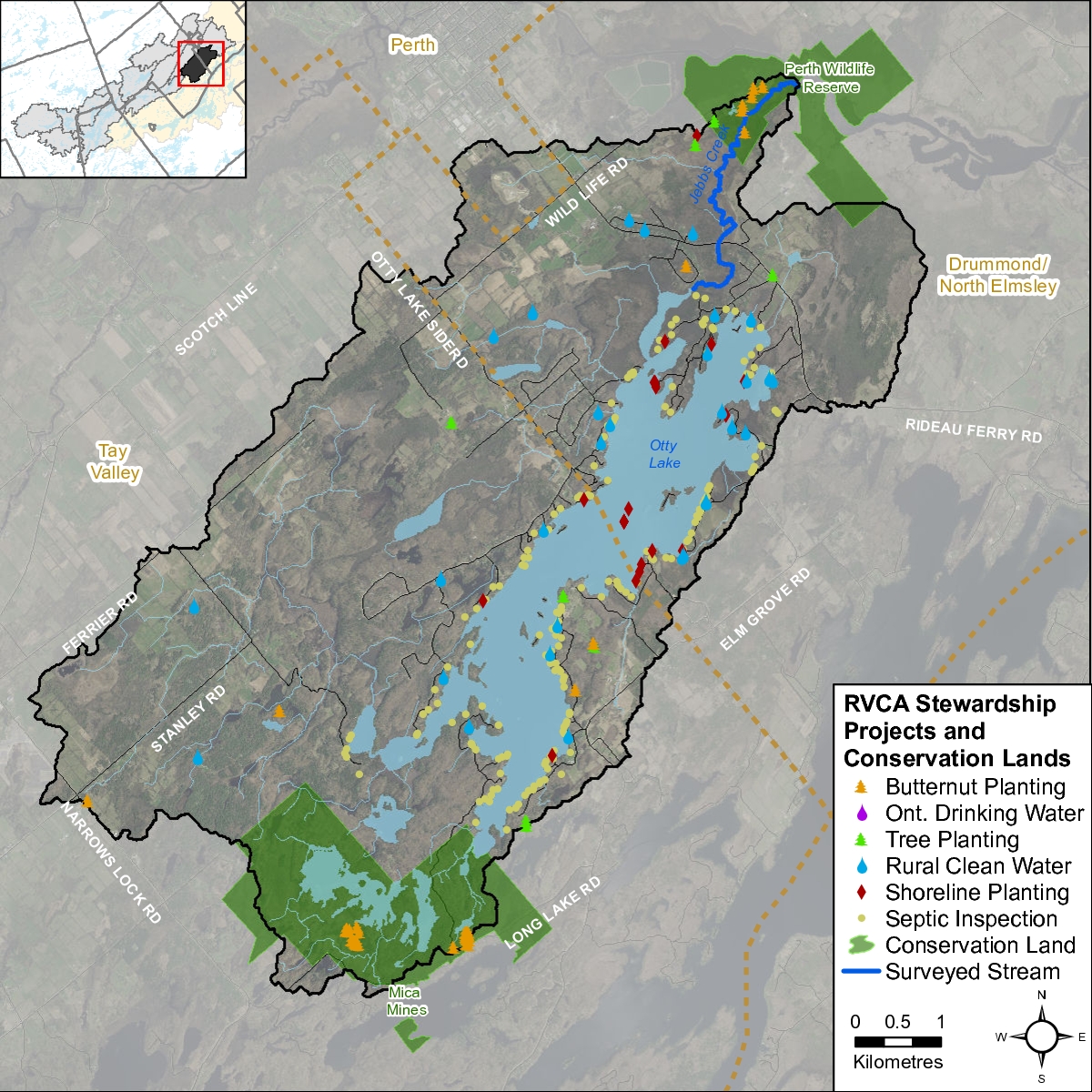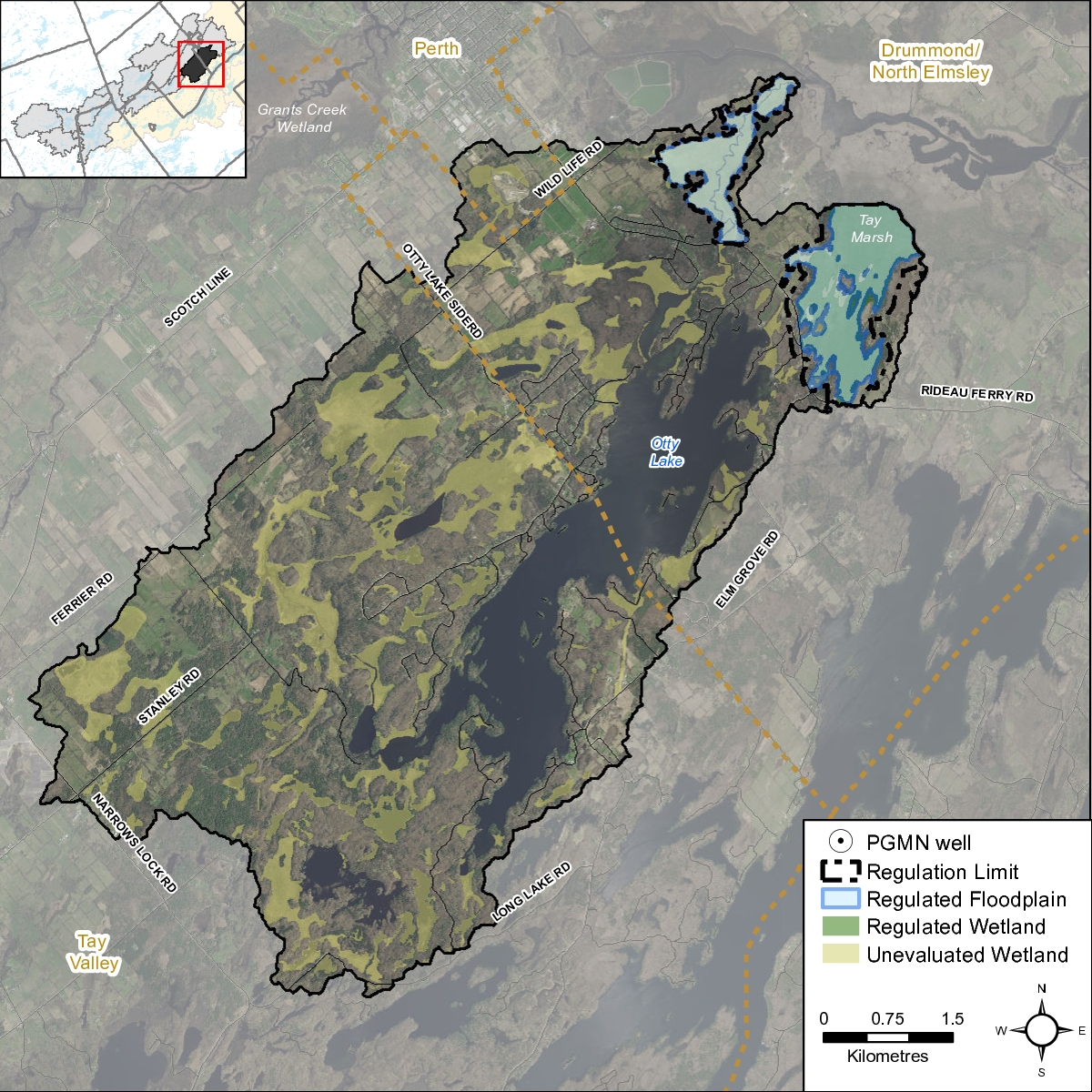5.0 Otty Lake Catchment: Stewardship and Water Resources Protection
The RVCA and its partners are working to protect and enhance environmental conditions in the Tay River Watershed. Figure 70 shows the location of all stewardship projects completed in the Otty Lake catchment.
5.1 Rural Clean Water
The Rural Clean Water Program provides technical and financial assistance to farmers and other rural landowners, to aid in the implementation of projects that protect water quality. Funding is granted to those projects that support best management practices for application in the protection and improvement of surface and ground water resources. The program also supports climate change adaptation and low impact development projects as well as educating rural landowners about environmental stewardship of private property. Examples of supported projects include livestock exclusion fencing, controlled tile drainage, cover crops, erosion control, well related projects, and many more. For a list of eligible projects and to apply for funding, see Rural Clean Water.
In the Otty Lake catchment from 2011 to 2016, seven septic system repairs, two erosion control projects, one windbreak/buffer and one well upgrade were completed; prior to this, eight septic system repairs, eight well upgrades, three education initiatives, one manure storage facility, one milkhouse wastewater treatment project, one well decommissioning, one well replacement and one livestock fencing project had been completed. When combined, these projects are keeping 26.41 kilograms of Phosphorus out of our lakes, rivers and streams every year. Total value of all 35 projects is $325,662 with $64,241 of that amount funded through grant dollars from the RVCA.
5.2 Private Land Forestry
Forest cover and tree planting continues to be one of the most widely supported strategies to improve our environment. The many benefits of forest cover include carbon sequestration, flood mitigation and water quality improvement as well as providing wildlife habitat.
Through the RVCA's Trees for Tomorrow Program (and its predecessors), 5,800 trees were planted at two sites from 2011 to 2016; prior to this, 9,747 trees were planted at six sites. In total, 15,547 trees have been planted resulting in the reforestation of seven hectares. Total project value of all eight projects in the Otty Lake catchment is $35,523 with $25,029 of that amount coming from fundraising sources. For more information about the Program and landowner eligibility, please see the following: Tree Planting in the Rideau Valley Watershed and Trees for Tomorrow.
An additional 191 butternut trees were planted through the RVCA Butternut Recovery Program at 42 project locations, as part of efforts to introduce healthy seedlings from tolerant butternuts into various locations across Eastern Ontario.
5.3 Shoreline Naturalization
Natural shoreline buffers rich in native plants are critically important to protecting the health of our lakes, rivers and streams. Shoreline vegetation protects water quality and aquatic habitat by intercepting potentially harmful contaminants such as nutrients, pollutants and sediment, regulating water temperatures, slowing runoff and providing important fish and wildlife habitat. Natural shorelines also help improve climate change resiliency by increasing flood storage and providing protection from erosion during extreme weather events.
Though the RVCA’s Shoreline Naturalization Program, landowners (private and public property owners) have naturalized more than 2.3 km of shoreline in the Tay Watershed by planting over 10,563 native trees and shrubs at 96 sites since 2008. In the Otty Lake catchment, a total of 2,506 native trees and shrubs have been planted along 407 metres of shoreline at an average buffer width of three metres for a total project value of $19,479. A number of these projects have been undertaken in partnership with community groups. The Program has also provided the Otty Lake Association with 1,500 native tree, shrubs and wildflowers that have been distributed to property owners around Otty Lake and supported a Toronto Dominion Friends of the Environment Tree Day hosted by RVCA at the Perth Wildlife Reserve, which saw the planting of 300 trees and shrubs by local volunteers in 2016. This was followed up in 2017 by a volunteer group planting native wildflowers at the Perth Wildlife Reserve to enhance the butterfly garden for local pollinators.
5.4 Fish and Wetland Habitat Improvement
Two fish and wetland improvement projects have been completed in the Otty Lake catchment in recent years: 1) The Otty Lake Association collaborated with the Rideau Valley Conservation Authority on the Otty Lake Fish Habitat Enhancement project to improve the recreational fishery for smallmouth bass and 2) The Jebbs Creek Wetland Embayment was completed by the RVCA to enhance fish and wetland habitat along Jebbs Creek. Sixteen hundred square metres of fish habitat were created and 15 volunteers planted a mixture of 125 native trees and shrubs and trees around the new wetland feature.
5.5 Septic System Re-inspection
Septic system re-inspection is provided by the RVCA through the Mississippi Rideau Septic System Office at the request of Drummond/North Elmsley and Tay Valley Townships.
Since 2004, the service has performed 357 mandatory and voluntary septic system re-inspections on 257 properties in the Otty Lake catchment, of which, nine voluntary inspections were conducted on seven properties around McLaren and Mud Lake (with only one system needing remedial work) along with 348 mandatory re-inspectionson 250 properties around Otty Lake. Remedial/maintenance work (i.e. pump outs and baffle replacements that generally do not require a permit) was advocated for 18 of those inspections on Otty Lake, septic system replacements required at another seven properties along with more information being requested during another two inspections.
5.6 Valley, Stream, Wetland and Hazard Lands
The Otty Lake catchment covers 53 square kilometres with 3.5 square kilometres (or seven percent) of the drainage area being within the regulation limit of Ontario Regulation 174/06 (Figure 71), giving protection to wetland areas and river or stream valleys that are affected by flooding and erosion hazards.
Wetlands occupy 11 square kilometres (or 21 percent) of the catchment. Of these wetlands, two square kilometres (or 18 percent) are designated as provincially significant and included within the RVCA regulation limit. This leaves the remaining 9 sq. km (or 82 percent) of wetlands in the catchment outside the regulated area limit.
Of the 98.6 kilometres of stream in the catchment, regulation limit mapping has been plotted along 5.6 kilometres of streams (representing six percent of all streams in the catchment). Some of these regulated streams (0.6 km) flow through regulated wetlands; the remaining five kilometres of regulated streams are located outside of those wetlands. Plotting of the regulation limit on the remaining 93 kilometres (or 94 percent) of streams requires identification of flood and erosion hazards and valley systems.
Within those areas of the Otty Lake catchment subject to the regulation (limit), efforts (have been made and) continue through RVCA planning and regulations input and review to manage the impact of development (and other land management practices) in areas where “natural hazards” are associated with rivers, streams, valley lands and wetlands. For areas beyond the regulation limit, protection of the catchment’s watercourses is only provided through the “alteration to waterways” provision of the regulation.
5.7 Vulnerable Drinking Water Areas
Mississippi-Rideau Source Water Protection Program has mapped the north boundary of the Otty Lake catchment as a Significant Groundwater Recharge Areas and all of the catchment as a Highly Vulnerable Aquifer. This means that the nature of the overburden (thin soils, fractured bedrock) does not provide a high level of protection for the underlying groundwater making the aquifer more vulnerable to contaminants released on the surface. There are no Well-Head protection Areas in the catchment.
The Mississippi-Rideau Source Protection Plan includes policies that focus on the protection of groundwater region-wide due to the fact that most of the region, which encompasses the Mississippi and Rideau watersheds, is considered Highly Vulnerable Aquifer. For detailed maps and policies that have been developed to protect drinking water sources, visit the Mississippi-Rideau Source Protection Region website.

